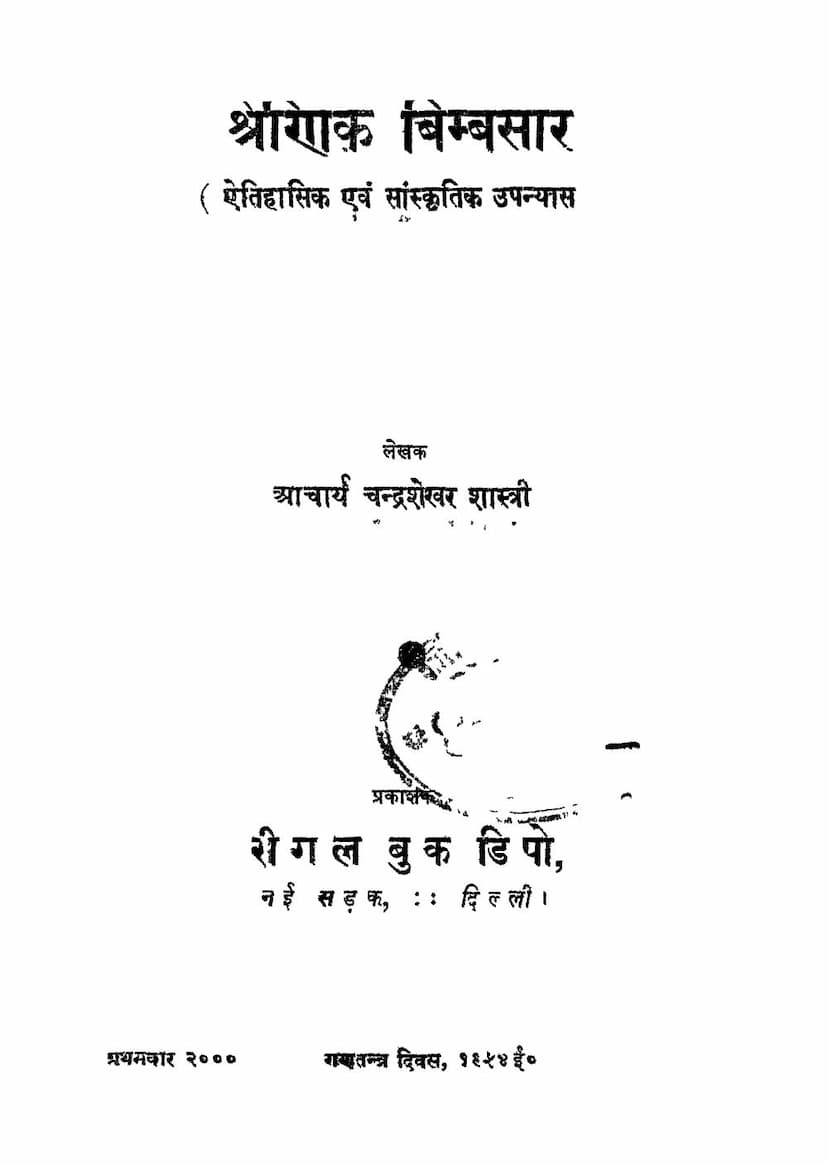Shrenik Bimbsr
Added to library: September 2, 2025

Summary
Here's a comprehensive summary of the Jain text "Shrenik Bimbsar" by Chandrashekhar Shastri, based on the provided catalog link and the text itself:
Book Title: Shrenik Bimbsar (श्रेणिक बिम्बसार) Author: Acharya Chandrashekhar Shastri Publisher: Rigal Book Depo, Delhi Publication Year: 1954
Overall Nature of the Work: "Shrenik Bimbsar" is presented as a historical and cultural novel, aiming to illuminate the life and times of King Shrenik Bimbisara, a significant figure in ancient Indian history, particularly within the context of Jainism. The author, Acharya Chandrashekhar Shastri, emphasizes the importance of historical accuracy in literature, critiquing what he perceives as factual distortions in other historical novels, particularly those by Chaturasen Shastri. The book delves into the political, social, and religious landscape of ancient India, focusing on the era of Bimbisara.
Key Themes and Historical Context: The narrative is deeply rooted in the historical and political milieu of the Solah Mahajanapadas (Sixteen Great Kingdoms) of ancient India. The author meticulously describes the geographical locations, governance systems, and inter-state relations of these kingdoms. The book highlights:
- The Rise of Magadha: It traces the origins and growth of the Magadha kingdom, from its early rulers like Brihadratha and Jarasandha to the establishment of the Shishunaga dynasty, culminating in Bimbisara's reign.
- Political Dynamics: The text explores the complex political landscape, including alliances, rivalries, and conflicts between prominent kingdoms like Magadha, Koshala, Avanti, and Vatsa. It also details the republican system of the Vriji confederacy with its capital at Vaishali.
- Religious and Philosophical Milieu: A significant aspect of the book is its exploration of the religious environment, particularly the contemporaneous existence and influence of Jainism and Buddhism. Bimbisara's interactions with both Lord Mahavira and Gautama Buddha are a central theme, with the author asserting that Bimbisara initially embraced Buddhism before becoming a follower of Jainism.
- Social and Cultural Aspects: The novel provides insights into the social customs, economic activities (like trade routes), and daily life of the era.
Central Character: King Shrenik Bimbisara: The book focuses on King Shrenik Bimbisara, portraying him as a powerful, politically astute, and religiously inclined ruler. The author emphasizes his strategic marriages for political alliances, his administrative capabilities, and his eventual patronage of Jainism. The narrative attempts to present a historically and religiously nuanced portrayal of Bimbisara, distinguishing it from what the author considers embellishments or misrepresentations in other works.
Narrative Structure and Content (as indicated by the Table of Contents): The extensive table of contents reveals a sprawling narrative that follows Bimbisara's life chronologically and thematically, interspersed with historical context:
- Early Life and Ascendancy: The initial chapters detail his lineage, the political situation leading to his rise, and his early challenges. The story of his birth, the examination of his suitability for kingship through trials, his exile, and his eventual return to claim the throne are covered.
- Reign and Expansion: The book covers his political acumen, including his marriage alliances (with Koshala princess, Kerala princess), his conquest of Anga, and the establishment of Rajagriha as his capital.
- Interactions with Religious Figures: Significant portions are dedicated to his encounters with Lord Mahavira and Gautam Buddha, their teachings, and Bimbisara's religious leanings. The book highlights the syncretic religious environment of the time.
- Family Life and Succession: The narrative touches upon his family, his sons (including Abhayakumara and Ajatashatru), and the complexities of succession.
- Conflict and Downfall: The later chapters describe Ajatashatru's conspiracy, rebellion, and eventual overthrow of Bimbisara, leading to the latter's death.
Author's Stance and Critical Approach: Acharya Chandrashekhar Shastri positions himself as a defender of historical and religious truth, particularly concerning Jainism. He explicitly criticizes other authors for what he deems "historical distortions" and "misinterpretations" in their portrayal of historical figures like Mahasati Chandanbala and Lord Mahavira. He argues for a distinct "historical sentiment" in novels that strictly adheres to established facts, allowing for imagination only in areas where history remains silent. He also advocates for expanding literary criticism to include "historical sentiment," "scientific sentiment," and "research sentiment" beyond traditional aesthetic sentiments.
Key Historical Figures and Events Mentioned:
- Kings and Rulers: Bimbisara, Ajatashatru, Bhuamukhi, Pulik, Pradyota, Chandpradyota, Senajit, Udaiyan, Virata, Shakuni, Pushkarasa, Nandivardhana, Mahapadmananda, Chandragupta Maurya.
- Religious Figures: Lord Mahavira, Mahasati Chandanbala, Gautam Buddha, Anand, Sariputra, Maudgalyayana, Devadatta.
- Key Events: The establishment of the Shishunaga dynasty, the rise of the sixteen Mahajanapadas, the wars between Magadha and its neighbors, the development of cities like Rajagriha and Vaishali, the socio-political and religious movements of Jainism and Buddhism.
- Concepts: The book also discusses concepts like the Solah Mahajanapadas, the Vriji confederacy, the classification of states (Swrajya, Vai-rajya, Bhojya, Samrajya), and the evolution of historical writing and literary criticism in India.
In essence, "Shrenik Bimbsar" is a historically grounded novel that aims to provide a detailed and religiously faithful account of King Bimbisara's reign within the rich tapestry of ancient Indian civilization, with a strong emphasis on promoting Jain principles and correcting perceived historical inaccuracies.